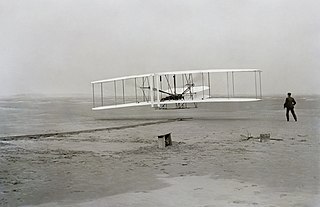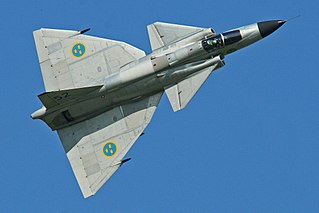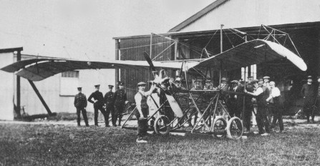Related Research Articles

In aeronautical and naval engineering, pusher configuration is the term used to describe a drivetrain of air- or watercraft with propulsion device(s) after the engine(s). This is in contrast to the more conventional tractor configuration, which places them in front.

In aviation, the term tractor configuration refers to an aircraft constructed in the standard configuration with its engine mounted with the propeller in front of it so that the aircraft is "pulled" through the air. Oppositely, the pusher configuration places the airscrew behind and propels the aircraft forward. Through common usage, the word "propeller" has come to mean any airscrew, whether it actually propels or pulls the plane.
The 1911 Curtiss Model D was an early United States pusher aircraft with the engine and propeller behind the pilot's seat. It was among the first aircraft in the world to be built in any quantity, during an era of trial-and-error development and equally important parallel technical development in internal combustion engine technologies.

In aeronautics, a canard is a wing configuration in which a small forewing or foreplane is placed forward of the main wing of a fixed-wing aircraft or a weapon. The term "canard" may be used to describe the aircraft itself, the wing configuration, or the foreplane. Canard wings are also extensively used in guided missiles and smart bombs.

Blériot Aéronautique was a French aircraft manufacturer founded by Louis Blériot. It also made a few motorcycles between 1921 and 1922 and cyclecars during the 1920s.
The Green Engine Co was a British engine company founded by Gustavus Green in Bexhill to sell engines of his design. He flourished especially as a designer of aeroplane engines during the first two decades of the 20th century. The engines were actually manufactured by the Aster Engineering Company.

The Breguet Aerhydroplane was a large experimental flying boat developed in France in 1912. It proved to be underpowered and never flew.
Captain Horatio Claude Barber (1875–1964) was an early British aviation pioneer and First World War flight instructor. In 1911 he flew the first cargo flight in Britain, transporting electric light bulbs from Shoreham to Hove. He was also the first person in Great Britain to gain an aeronautical degree.

The Cody IV monoplane was a single-engined monoplane designed and built by the American-born but British-based aviation pioneer Samuel Franklin Cody in 1912. It was intended for entry into the 1912 British Military Aeroplane Competition, but was wrecked in a crash before the start of the competition.

The Dunne D.7 was one of J. W. Dunne's swept wing tailless aircraft designed to have automatic stability, first flying in 1911. It was a single seat, single engined pusher monoplane developed from the unsuccessful D.6.

The Green D.4 was a four-cylinder watercooled inline piston engine produced by the Green Engine Co in the UK in 1909. It produced about 60 hp (45 kW) and played an important role in the development of British aviation before World War I.

The Short S.27 and its derivative, the Short Improved S.27, were a series of early British aircraft built by Short Brothers. They were used by the Admiralty and Naval Wing of the Royal Flying Corps for training the Royal Navy's first pilots as well as for early naval aviation experiments. An Improved S.27 was used by C.R. Samson to make the first successful take-off from a moving ship on 9 May 1912.

The ASL Valkyrie was a canard pusher configuration aircraft designed by the Aeronautical Syndicate Ltd in 1910. Examples were widely flown during 1911 and were used for instructional purposes at the ASL flying school, which was the first occupant of Hendon Aerodrome in London.

The ASL Viking was a single-engined two seater biplane aircraft designed and built by Horatio Barber's Aeronautical Syndicate Ltd. at Hendon. It was first flown in January 1912.
The Scottish Aeroplane Avis was a tractor monoplane built by Howard T. Wright in 1909. At that time Wright was one of England's foremost aircraft engineers, and had several monoplane aircraft under development. The Avis was shown at the 1910 Aero Exhibition in London and several examples were successfully flown during 1910.
The Aerial Wheel Monoplane was an experimental British aircraft built during 1912 in order to compete in the Military Aeroplane Competition which was to be held at Larkhill on Salisbury Plain in August of that year. It was not assembled in time, and the aircraft was not allowed to enter the competition.
The Grahame-White Type VI was an early British military aircraft manufactured by the Grahame-White Aviation Company. Only one was built but after an abortive flight development was abandoned.

The Caudron Type A was the first successful aircraft built by René Caudron and his brother Gaston. During 1910 the Caudron brothers were briefly associated with the Société Anonyme Français d'Aviation (S.A.F.A.), and an example of the type was exhibited at the 1910 Paris Aero Salon as the S.A.F.A. Biplane.

The pioneer era of aviation was the period of aviation history between the first successful powered flight, generally accepted to have been made by the Wright Brothers on 17 December 1903, and the outbreak of the First World War in August 1914.
References
Citations
Bibliography
- Brown, Timothy C.; Flying with the Larks: The Early Aviation Pioneers of Lark Hill, Spellmount (History Press), 2013.